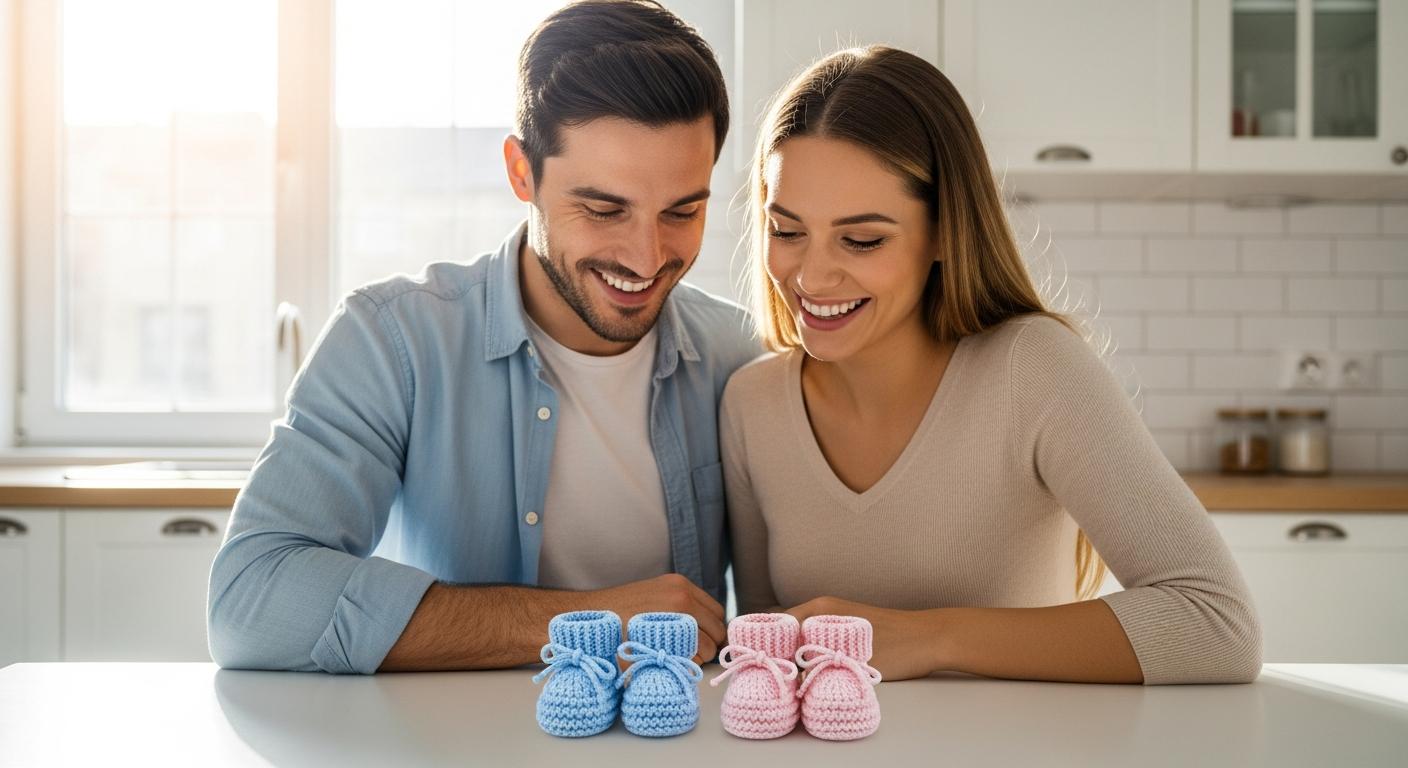Curious about what friends keep mentioning at family dinners, a calendar that guesses boy or girl using two dates, and unsure where medical facts fit in, you are not alone in wondering how to try it safely. The Chinese pregnancy calendar is playful, steeped in culture, and easy to enjoy when you understand what it can and cannot do. You will find clear steps, date conversion tips, science based context, IVF specifics, and a calm way to keep the fun without letting stress creep in.
what the calendar is and why families try it
The Chinese pregnancy calendar matches two inputs to predict sex. One, the mother’s Chinese lunar age at conception. Two, the lunar month of conception. Cross the row and column on a grid, and out pops a prediction. Simple, right, almost too simple, which is exactly why it sparks conversation.
Why do parents try it
- Curiosity, it is a light moment at a baby shower or dinner table.
- Cultural continuity, a nod to tradition that grandparents may cherish.
- An icebreaker, a way to daydream about names before ultrasound or blood tests.
A gentle boundary, it is entertainment, not a test. Ultrasound, noninvasive prenatal testing, often called NIPT, and diagnostic procedures are the tools that provide reliable information.
cultural roots and respectful use
You may picture old almanacs on a scholar’s desk. That is not far off. The idea aligns with the Chinese calendar, a tradition that ties human life to lunar and seasonal rhythms. Folklore often mentions court charts, yet historians cannot pinpoint a single origin document. The modern version you see online is a distillation of older ideas, reduced to two variables to keep it usable at the kitchen table.
Respect matters. In some places and eras, sex preference and sex selection carried real harms. If you enjoy this tradition, keep it kind, avoid bias, and let your medical decisions follow evidence and local laws. If questions arise, a clinician can help with clarity and care.
how to use the calendar step by step
You want a straightforward path. Here it is, from dates to a playful outcome.
step 1, gather the dates
- Your full birth date in the Gregorian calendar, and where you were born for accurate local time if needed.
- Your best estimate of conception, for natural conception use ovulation or the narrowest fertile window, for IVF or ICSI use fertilization date if available, transfer date only as a backup.
step 2, convert birth date to Chinese lunar age
Core rule, at birth you are 1, and you add a year at Chinese New Year, not on your birthday. Two options
- Precise path, use a converter that respects local dates and the Chinese New Year increment.
- Quick approximation, your Western age at conception plus 1. This shortcut works for a recreational approach, but January and February births can deviate.
step 3, handle common age edge cases
- Born in January or February, because Chinese New Year shifts between late January and mid February, some versions treat births before the New Year as part of the prior lunar year. A few tables add 2 instead of 1 for certain January and February cases. Results can differ across websites.
- Time zone, always use local dates for both birth and conception.
step 4, determine the conception date
Natural conception
- Using last menstrual period as a proxy, many cycles ovulate about 14 days after the first day of bleeding in a 28 day cycle, individual patterns vary.
- Tools such as basal body temperature charts, cervical mucus tracking, and ovulation predictor kits narrow the fertile window.
- Irregular cycles, early ultrasound can refine timing.
IVF and ICSI
- Prefer the exact fertilization date from the lab. If you only have transfer date, note whether the embryo was day 3 or day 5 at transfer, the shift of a few days can move you across a lunar boundary.
step 5, convert conception to the lunar month
Use a converter that maps Gregorian dates to lunar months. The lunar calendar resets with the new moon, months last about 29 to 30 days, and some years include an extra leap month to stay aligned with the seasons.
step 6, cross reference the chart
Find the row for the maternal lunar age, find the column for the lunar month of conception, read the cell. That is your prediction from the Chinese pregnancy calendar.
step 7, keep uncertainty in view
Small shifts in dates, leap month rules, and boundary days around Chinese New Year can flip a result. Treat it as a friendly guess and enjoy the moment.
converting lunar age without tools
What lunar age means
Everyone begins at 1, and everyone ages together at Chinese New Year. For the Chinese pregnancy calendar, use the maternal lunar age at the time of conception.
A practical manual method
- List the Chinese New Year date for the birth year and for every year up to the conception year.
- Count the number of Chinese New Year celebrations that have occurred between your birth and your conception date, using local dates.
- Lunar age at conception equals 1 plus the count you just made.
A quick rule of thumb
- Lunar age is approximately Western age at conception plus 1. January and February births are the ones that most often need a closer look.
pinpointing the lunar conception month
Why a converter helps
A date like March 10 does not automatically map to the same lunar month each year. The calendar is a lunisolar calendar, months follow the moon, and Chinese New Year drifts within several weeks on the Gregorian calendar. A converter or official new moon table keeps you accurate.
Situations that can confuse
- Conception very close to Chinese New Year.
- Conception in a leap month that some charts list and others merge with the previous month.
- Irregular cycles that span two new moons.
Time zone tips
Use the local date where conception or IVF occurred. If you are working with a clinic, tell them your time zone so ultrasound dating and records align.
reading layouts and handling variants
Most charts use a grid, maternal lunar age on one axis, lunar month on the other. Variations exist. Some swap axes. Some include a column for the leap month. A few replace text with zodiac icons. If an output differs from another website, check which age system they used and how they handled leap months.
A simple four step reading method
1) Calculate lunar age.
2) Convert conception date to the lunar month.
3) Find the age row and month column.
4) Read the result, then keep it playful.
Boundary cases
If dates sit near Chinese New Year or a leap month, try the adjacent option. You may see the result flip. That is normal for a system tied to lunar boundaries.
ivf and assisted reproduction specifics
Anchors that work best
- Fertilization date, this is the biological start and the cleanest anchor.
- Transfer date, use only if fertilization is not available, and note embryo age at transfer.
Clinic alignment
If the clinic standardizes to a particular event for records, match that choice when you use the Chinese pregnancy calendar so your dates stay consistent.
why results vary year to year
Two drivers create drift
- Chinese New Year moves between late January and mid February in the Gregorian calendar.
- Some years include a leap month, which reshapes the numbered lunar months.
What this means for families
A Gregorian date like February 10 might belong to the last lunar month one year and to the first lunar month in the next year. That is why the Chinese pregnancy calendar works only when you anchor to the actual year of conception.
choosing a chart and good tools
Look for
- Day level Gregorian to lunar conversion, with clear leap month labeling, and accurate Chinese New Year boundaries.
- Transparent documentation of whether the tool uses lunar age or Western age, and which event is treated as conception.
- Time zone awareness and local dates.
Helpful features for parents
- Dual display of Gregorian and lunar dates, leap months visible at a glance.
- Inputs for last menstrual period, cycle length, ovulation date, fertilization and transfer dates, birth date, and time zone.
- Clear reminders that it is for fun, and not a medical test.
accuracy and science
You might ask, does it work beyond chance
Large datasets say no. A frequently cited study from 2010 in Paediatric and Perinatal Epidemiology assessed hundreds of thousands of births and found accuracy hovered around 50 percent. In other words, comparable to a coin toss.
Why it can feel right in families
- Memory bias, hits are shared with laughter, misses fade quickly.
- Small numbers, a few correct predictions in one family do not make population level evidence.
- Input wiggles, ambiguous conception timing or different age rules can create occasional accidental matches.
The bottom line
Enjoy the Chinese pregnancy calendar as folklore. For medical certainty, rely on ultrasound, NIPT, or diagnostic tests when recommended by your clinician and regulations.
medical timing, due dates, and what matters in care
While you are having fun with traditions, it helps to keep clinical timing straight. Your gestational age is the pregnancy age counted from the first day of the last menstrual period, not from ovulation. Your estimated due date is calculated from that same starting point, and ultrasound can refine it in the first or second trimester.
Helpful anchors for care
- First trimester, discussions about screening options like NIPT can begin, usually around the end of the first trimester depending on local rules.
- Second trimester, anatomy ultrasound around 20 to 22 weeks can often identify sex when the view is clear.
- Third trimester, growth and wellbeing checks help finish the journey.
A steady prenatal care timeline supports screening, vaccinations, and guidance tailored to you. The Chinese pregnancy calendar sits outside this medical pathway, a conversation piece rather than a clinical tool.
versions, discrepancies, and a quick reconciliation checklist
Why sources disagree
- Different age systems, some use lunar age, others use Western age.
- Leap month handling, separate versus merged into the prior month.
- Different definitions of conception, real fertilization in IVF, transfer day, ovulation, or an LMP proxy.
- Boundary rules around Chinese New Year.
Checklist to harmonize
1) Confirm the age convention.
2) Check how leap months are treated.
3) Standardize your conception anchor, fertilization for IVF, ovulation based estimate for natural conception.
4) Use the same converter for every comparison.
5) If results still differ, choose one transparent method and be consistent.
family friendly ways to enjoy it
Looking for ideas
- Make a little reveal at a family meal. Share the Chinese pregnancy calendar result on a card, then see what ultrasound says later for a friendly twist.
- Ask guests to write guesses before the scan. Compare with the calendar prediction and laugh together.
- Test older siblings or cousins retroactively. People love to see how the grid would have guessed.
Light touch, low pressure
Keep it playful. If the calendar conflicts with medical results, trust the medical result. If exact timing is fuzzy, accept that the output may wobble.
glossary for quick clarity
- conception date the day sperm and egg meet, for IVF this is fertilization in the lab
- LMP last menstrual period, used to estimate pregnancy timing
- ultrasound dating refining gestational age using measurements
- CVS and amniocentesis diagnostic procedures that determine chromosomes with very high accuracy when indicated
- NIPT a blood test that screens for certain chromosome findings and can detect Y chromosome material in many settings
- Due date the day you reach 40 weeks by convention, an estimate that can shift with early ultrasound
balancing tradition and evidence, practical answers to common questions
Does the Chinese pregnancy calendar affect fertility or baby health
No. It does not influence biology, it only labels a cell in a grid based on age and month.
Can timing conception by month change the odds of boy or girl
Evidence does not support this approach. Sex is determined at fertilization by the sperm chromosome, and timing by calendar month does not shift that probability.
Is the Chinese gender chart different from the Chinese pregnancy calendar
Most people use the terms interchangeably. The layout may differ from site to site, yet the two inputs are the same, maternal lunar age and lunar conception month.
How often should I repeat the calculation
Once per conception is enough. If your dates sit near a boundary, you can check the neighboring month and note that the result may flip.
seo friendly terms you may see in tools and articles
You may encounter phrases like Chinese pregnancy calendar chart, Chinese birth calendar, Chinese lunar pregnancy chart, or Chinese gender predictor. These are variations of the same concept, which maps age and lunar month to a playful prediction linked to traditional Chinese pregnancy beliefs.
key takeaways
- The Chinese pregnancy calendar blends cultural tradition and curiosity, it pairs maternal lunar age with the lunar month of conception to generate a playful prediction.
- Accurate conversion matters, Chinese New Year is a moving boundary, leap months exist, and small date shifts can change the result.
- Scientific studies show no predictive power beyond chance. For reliable sex information, use ultrasound, NIPT, or diagnostic testing as advised by your clinician.
- IVF users should anchor to fertilization when possible, transfer date only if no better option exists.
- Choose tools that respect local dates, leap months, and time zones. Keep inputs consistent if you compare versions.
- Enjoy the tradition, avoid pressure or bias, and keep medical choices grounded in evidence based care.
- If you want personalized health tips and child health questionnaires at no cost, you can download the application Heloa.
Before you go, one last reminder. Use the Chinese pregnancy calendar for fun, protect your peace, and let your care team guide the medical milestones that matter most.
Questions Parents Ask
Can I use the chart for twins or other multiples?
Parents often wonder this — it’s a natural question. The chart itself only uses maternal lunar age and the lunar month of conception, so it doesn’t account for whether one or more eggs were fertilized. For multiples:
- Identical twins come from one fertilized egg and will share the same sex, so a single prediction would apply to both.
- Fraternal twins result from two separate fertilisations; each baby’s sex is determined independently, so the chart’s single-cell “prediction” can’t reliably describe both.
In short, the calendar wasn’t designed for multiples. Treat any result as a light-hearted guess and rely on ultrasound or clinical testing for accurate information. It’s perfectly normal to feel excited or curious — and also to prefer waiting for medical confirmation.
Does the calendar work for people of different nationalities or ethnic backgrounds?
It’s understandable to ask whether background matters. The method originates from Chinese lunar tradition, but scientific studies show the chart’s accuracy sits around chance levels in large, modern datasets. There’s no solid evidence that ethnicity or nationality makes the chart more accurate. So:
- Feel free to enjoy the tradition regardless of background.
- Keep in mind that its predictive value hasn’t been proven across populations.
If you want a reliable answer about sex, ultrasound or genetic tests remain the trustworthy routes. Enjoying the calendar as cultural folklore is valid — just without expecting a medical result.
Is it culturally appropriate or respectful to use this method for planning or sharing?
Many parents worry about respect and cultural sensitivity — that’s an important concern. Using the calendar as a fun, family activity is usually fine, especially when presented gently and without pressure. A few points to help navigate conversations:
- Acknowledge its origins as a Chinese tradition and treat it with respect.
- Avoid using it to justify sex preference or any form of selection; historically, that has caused real harm in some places.
- If family members take it very seriously, you might frame it as a playful tradition you enjoy while trusting medical testing for decisions.
If you’re uncertain about others’ feelings, a simple, kind comment that you’re sharing a cultural tradition for fun tends to keep things warm and respectful.










